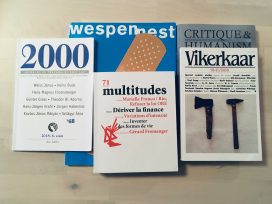Abstracts Multitudes 30 (2007)
Chantal T. Spitz
Traversées océaniennes
To this day, Polynesian people continue to be reduced to the myth of the Good Savage. Beyond fables of innocence, protection, and salvation, it is essential to reintegrate them within a truly human history, which accepts men and women in their bravery as well as in their pettiness, in their treasons as in their truthfulness, in their violence as in their generosity, in their hate as in their compassion. This would call for the deconstruction of 200 years of domination, imperialism, and occupation. This would also put into question most of the current approaches, which assume that civilization has to be Western, that Progress has to be material, and that the future has to be globalized.
James Clifford
Articulations indigènes / Futurs traditionnels (extraits)
In these extracts from longer essays, James Clifford deals with the question of the dynamics of indigenous cultures. Following the ideas of Jean-Marie Tjibaou, he exposes the different dialectics that inhabit the relations to place and localization of power with regard to their terms of articulation. Across the dialectics that variously link aboriginal histories and diasporas, origins and dislocations, and the relations between past, present, and future, Clifford explores the array of indigenous arrangements tangled up in the post- and neo-colonial situations and the stakes behind the reappropriation of sovereignty.
Djon Mundine
Micky Garrawurra et Tom Djumburpur. Deux hommes paisibles
A crucial dimension of the Aboriginal populations’ capacity to survive is linked to our capacity silently to observe the environment’s movements, in order to see movement where no movement can be seen. Micky Garrawurra and Tom Djumburpur’s works resemble beams of light indicating that something hidden is moving rapidly.
Barbara Glowczewski
Survivre au désastre. ” We Got to Move on “, disent les Aborigènes de Palm Island
Aboriginal communities in Australia are exiles in their own country and are becoming progressively more like domestic refugees. As in the case of refugee camps, they are not only subject to constant harassment from agents of various Australian governmental organizations, but also by forces or representatives of the global market. Faced with globalization, Aborigines experience hybrid articulations between modern technology and a nomadic lifestyle on a daily basis. Nevertheless, their local situation – which is the result of two centuries of colonial history – remains dramatic. The hardship of their situation often culminates in violent and tragic events, as at Palm Island, where riots broke out following the death of an Aborigine held in detention. Such events have the effect of polarizing relations between Australian society and Aboriginal communities. Why is it that Aborigines who remain with their communities and Aborigines who left both experience the same desolation today? In order to answer this question – which concerns all the indigenous people in Australia and beyond, it is necessary to employ the perspective of an anthropology of disaster survival, not in the sense of an aesthetic of misfortune and “bare life”, but as an ethics of hope.
Hélène Claudot Hawad
La furigraphie pour briser l’encerclement. Encres furigraphiques de Hawad
There is a recurrent image that captures the experience of being dominated and marginalized by the modern nation-states system which many Touaregs have felt in the political, economic, social, and cultural realms: that of a mutilated, injured body deprived of its freedom to move around. So the idea arises of putting together again, of rearticulation this social body in order to counter its fragmentation and paralysis and bring it back to its former mobility. It is in this perspective that over the past scores of years various initiatives have sprung up, ranging from armed resitance to imaginary discourses. In literature, it has been the “furigraphy” of the Touareg painter and poet Hawad that appears to be one of the paths available to “go beyond the limits, to route around the confinement, to make the echoes of the landscape rebound and to build fresh spaces of thoughts, feelings, and different ways to look at the world”.
Dominique Samson Normand de Chambourg
Condamnés à vivre ? Des peuples autochtones minoritaires du Nord sibérien face au XXIe siècle
As in other parts of the world, the autochthonous territories of the Russian Federation are under the threat of vast industrial projects. Polar Ural Industrial threatens the Mansis and Man’ Uskve’s ethnographic camp, where the intelligentsia has been coming since 1994, to maintain language, folklore, and ethnography for future generations. Between such threats and vapours of alcohol, the Tundra Nenets, the Khantes, the Mansis, and the Taiga Nenets are once again condemned to explore their tradition in order to strengthen the roots of the future.
Érémeï D. Aïpine
De la terre, de la langue et du mode de vie
Autochthonous people in general, and Siberia’s Finno-Ugrian people in particular – the Khantes and the Mansis – can only maintain their existence by being grounded in a territory necessary to the development of their language and way of life. But this territory is constantly amputated by industrial expansion, in search of oil, gas, and other natural resources. This is why defending autochthonous rights and interests is an urgent imperative.
Xavier Dias
The Right and the Wrought. Identité ethnique, conscience politique et activisme
The Adivasi rely on images that are both negative as well as positive to move them in the construction of a new political identity that experiments with the possibilities of change. They have begun, in this vein, to redefine their daily life in light of their political struggles, expressed in terms of ethnicity. The association of this new political consciousness with a new activism has led to the emergence of a pan-Adivasi identity – a collective response to the colonial and neo-colonial situations to which they have been subjected that transcends identifications made in terms of village or clan and thus that is witness to the active power of resistance and the schematics of a new mode of life.
Alexandre Soucaille
Chemin faisant en région sauvage. Rencontres entre Autres sur la terre de l’action politique
What are the reasons for autochthonous claims? Being autochthonous is not so much based on belonging to a particular location as on providing an experimentation in other forms of agency. These forms come from heterogeneous positions of gaps and separations, situated in the cosmological exteriority of the autochthonous people, who thus resist the hegemonic administration of populations.
Antony Hudek
L’enthousiasme, ou le cinéma à venir
Enthusiasm, a project launched in 2002 by the artists Neil Cummings and Marysia Lewandowska, inventories hundreds of films created by amateur filmmakers in Poland from the 1960s to the late 1980s. On the basis of this previously unavailable film archive, the two artists have elaborated a network or stratification of narratives – concerning a certain mode of collective film production and distribution, a visualization of socialism as lived from within, and a (necessarily indirect) transmission of historical-political enthusiasm. This essay attempts to highlight the link – palpable in the exhibitions of the project both in Europe and America – between such an enthusiasm and a conception of cinema as a historical vestige in a process of perpetual becoming, from the Russian avant-garde of the 1920s all the way to certain recent artistic productions by Lewandowska/Cummings as well as Pierre Huyghe or Douglas Gordon, via the filmic works of Jean-Luc Godard and Chris Marker.
Thomas Berns
Machiavel : rire de la crainte
This article explains Machiavelli’s inverted and blasphemous usage of certain selected truths of theological and/or political discourse, by his self-imposed requirement to mock fear (particularly the fear of disorder) by treating it as the common affect of political philosophy. The laughter which flows from this mockery of philosophy also stands for the interruption of dialogue as a foundational philosophical practice.
Charles T. Wolfe
Le rire matérialiste
The figure of the materialist philosopher as the “laughing philosopher”, who mocks the rest of humanity, its fears, superstitions, and even values, is a classic one. It has been associated variously with Democritus, Epicurus, Spinoza, Rabelais, La Mettrie, and others. Apart from the interest one might have in this figure of the philosopher as someone who is rather far removed from school benches, the present essay seeks to describe or (re)define this conceptual character in order to argue that laughter is the materialist philosopher’s “mode of access” to the human world, the so-called world of “values”. This implies that the equally classic reproach towards materialism – its coldness, its inability to grasp the dynamics of human action, what Flaubert would have called an “anatomist’s cruelty” – fails; or only successfully targets materialism when it laughs.
Pascal Houba
Vers une éthique du rire à l’époque de sa reproduction industrielle
In order to understand the unease or discomfort I experienced during a performance of contemporary dance and theatre which tried to create a humorous sense of distance towards suffering, I reflect on several personal experiences in order to arrive at an understanding of public laughter. This theorization relies on an understanding of the singularity of our embodiment and our social development. This singularity can only be understood by relating it to the popular concepts of the grotesque body and ambivalent laughter, which Bakhtin studied in Rabelais.
Régis Tomàs
Le plaisir de rire
According to Bergson, there is no laughter without an “anesthesia of the heart”. A kind of malice always ultimately lies in the depths of the pleasure of laughter. Can this pleasure be moral? It creates an affective community which can be both the site of identity and that of challenge, of calling everything into question. Cathartic, conservative, revolutionary, philosophical, desperate, the pleasure of laughter is a complex passion which must be taken seriously.
William Wood
Le rire comme arme chez Joe Orton
This paper is a brief introduction to and interpretation of the work of Joe Orton, an English playwright of the 1960s who achieved notoriety through the violent and obscene content of his plays, his scandalous homosexual lifestyle, and his brutal death at the hands of his lover. Orton’s work is presented as a dramatic exemplification of distinctive themes pertaining to a radically materialistic strain in philosophy anticipated in Machiavelli and Spinoza but finding its fullest expression in Deleuze’s thought: the radical immanence of the political, the critique of self-identity and clinical concepts of madness, and the anarchic and impersonal force of sexual desire. Orton achieves this aim through comic experimentation with language and a radicalization of farce that serve to produce a laughter that is both destructive and affirmative: destructive of the boundaries artificially erected by reason (including the boundary between the artificial and the natural), and affirmative of this process of destruction and the pre-subjective desire through which it is accomplished.
Adrien Guignard
Sokal et Bricmont sont sérieux ou : le chat est sur le paillasson
The following text seeks to identify the origins of what has come to be called the Sokal hoax. It appears that these origins remain problematic insofar as they cannot be thought of without engaging into intrinsically duplicitous thinking. Thus, “originally”, the gesture of the hoax is indeed “productive and conflictive, and no self-identity, no unity, and no inherent simplicity can possibly precede it”, as “he” said, but “he” was disseminating, as we say. But that is precisely the “strength” of the “form” of the Sokal hoax. With the delicate question of origins as its stumbling block – a stumbling block which may also be the question of irony – the present text takes its cue from a passage from La Barbarie à visage humain and proposes to reveal the constructive consequences of the affair triggered by the hoax, while constantly paying tribute to its performance. Whether my argument will make it possible to distinguish the consequences from the origins remains moot: post hoc ergo propter hoc. One must remember that this is a sophism.
Published 30 August 2007
Original in French
Contributed by Multitudes © Multitudes Eurozine
PDF/PRINTNewsletter
Subscribe to know what’s worth thinking about.



